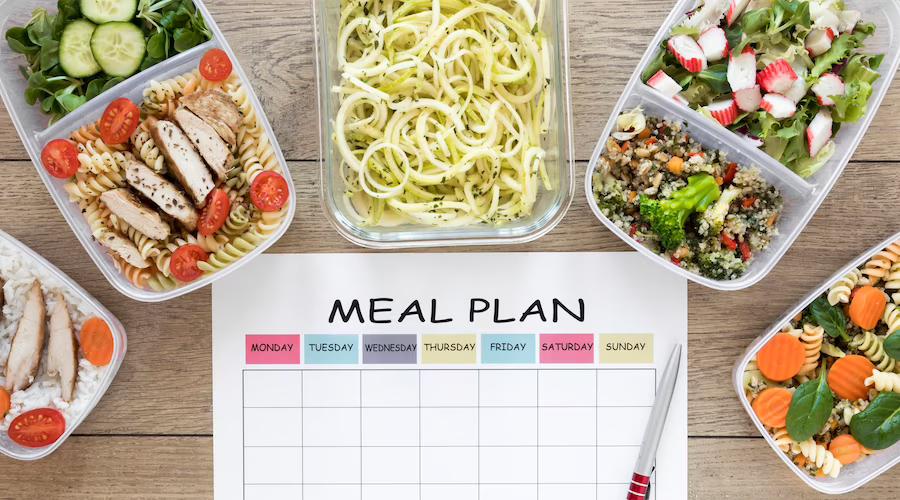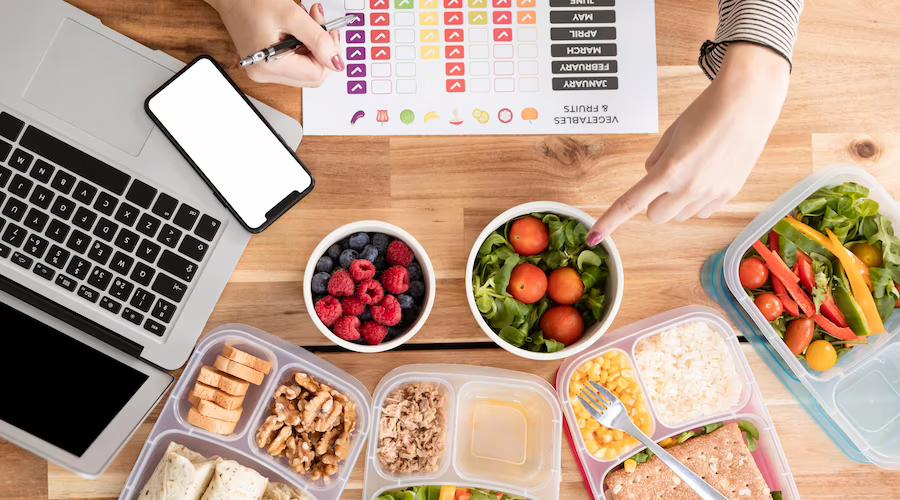Meal planning can be a daunting task, but it doesn’t have to be. With the right strategies and tools, meal planning can be easy and stress-free. In this blog post, we will explore various tips and techniques to make meal planning a breeze. From meal prep to grocery shopping, we will cover everything you need to know to create a successful meal plan that fits your lifestyle and dietary needs.
Whether you are a busy parent, a college student, or someone trying to eat healthier, this post will provide you with the knowledge and resources to make meal planning easy and enjoyable. So, let’s dive in and discover the secrets to meal planning made easy.

Benefits of Meal Planning
Meal planning can bring a range of benefits to individuals looking to improve their diet and nutrition. One of the key advantages is saving time and money by reducing food waste and avoiding last-minute trips to the grocery store. Additionally, meal planning can help people maintain a healthier diet by making it easier to control portion sizes and make healthier food choices.
Save Time and Money with Meal Planning
Meal planning can help save time and money by reducing the need for frequent trips to the grocery store and minimizing food waste. When meals are planned in advance, you can create a shopping list for the exact ingredients needed, which can help you save money and reduce impulse buying. Additionally, meal planning can save time by allowing you to prepare meals in advance, which can be especially helpful on busy days when you don’t have time to cook from scratch.
Maintain a Healthier Diet with Meal Planning
Meal planning can help you maintain a healthier diet by allowing you to make deliberate and informed choices about the food you eat. When you plan your meals in advance, you have more control over the types and amounts of food you consume, which can help you meet your nutritional needs and achieve your health goals.
Additionally, meal planning can help you avoid unhealthy convenience foods and fast food options, which are often high in calories, sugar, and unhealthy fats.
Reduce Food Waste with Meal Planning
Meal planning can help reduce food waste by allowing you to use ingredients more efficiently and effectively. When you plan your meals in advance, you can create a shopping list for the exact ingredients needed for each recipe, which can help reduce the amount of food that goes to waste. Additionally, meal planning can help you use leftovers in creative ways, reducing the amount of food that goes to waste and saving you money in the process.

Getting Started with Meal Planning
Meal planning can seem overwhelming, but with some simple steps, it can become a regular part of your routine. Start by setting realistic goals for yourself and choosing a meal planning method that fits your lifestyle. Creating a master list of go-to recipes and ingredients can also help make meal planning easier and more efficient.
Set Realistic Goals for Your Meal Planning
Before diving into meal planning, take some time to think about your goals and priorities. Consider your schedule, budget, dietary needs, and any other factors that may impact your meal planning. Some tips for setting realistic goals include:
- Start small and work your way up. Don’t try to plan out every meal for the entire week at once. Instead, start with planning a few meals for a couple of days and gradually increase the number of meals you plan.
- Consider your time constraints. If you have a busy schedule, plan meals that are quick and easy to prepare. If you have more time on certain days, plan more elaborate meals for those days.
- Factor in your budget. Choose recipes and ingredients that fit within your budget and don’t break the bank.
- Be flexible. Meal planning is not set in stone, so be open to making adjustments and modifications as needed.
Choose Your Preferred Meal Planning Method
There are several methods for meal planning, and it’s important to choose one that works best for you. Some common meal planning methods include:
- Weekly meal planning: This involves planning out all meals for the week in advance.
- Batch cooking: This involves preparing large batches of meals in advance that can be eaten throughout the week.
- Meal kit delivery: This involves subscribing to a meal kit delivery service that provides pre-portioned ingredients and recipes.
Create a Master List of Go-To Recipes and Ingredients
Creating a master list of go-to recipes and ingredients can help make meal planning easier and more efficient. Some tips for creating a master list include:
- Keep a list of favorite recipes and ingredients that are easy to make and enjoy.
- Include a variety of recipes to prevent boredom and to ensure a balanced diet.
- Keep a well-stocked pantry and freezer with essential ingredients that can be used in a variety of recipes.
- Take advantage of seasonal produce to add variety and save money.

Tips and Tools for Successful Meal Planning
Meal planning can be a game-changer for anyone looking to maintain a healthy diet, save time, and reduce food waste. However, it can be challenging to get started or stay on track without the right tips and tools. Here are some helpful tips and tools for successful meal planning.
Make Use of Online Meal Planning Resources
There are a variety of online resources available to make meal planning easier. From recipe databases to meal planning apps, these tools can help you save time and create a well-balanced meal plan. Some popular meal planning resources include:
- Meal planning apps such as Mealime, Paprika, and Prepear
- Recipe databases such as Allrecipes, EatingWell, and Food Network
- Grocery delivery services such as Instacart, Amazon Fresh, and Walmart Grocery
Invest in Quality Meal Prep Containers and Tools
Investing in quality meal prep containers and tools can make a big difference in the ease and effectiveness of your meal planning. Some useful tools to consider include:
- Glass or BPA-free plastic meal prep containers in a variety of sizes
- A digital food scale for accurate portioning
- A slow cooker or Instant Pot for easy batch cooking
- Reusable silicone storage bags to reduce waste
Utilize Batch Cooking and Freezing to Save Time
Batch cooking and freezing can be a lifesaver for busy individuals or families. By preparing large batches of meals or ingredients ahead of time, you can save time and have meals ready to go throughout the week. Some batch cooking and freezing tips include:
- Preparing large batches of protein (such as chicken, beef, or tofu) to use in multiple meals
- Making big batches of soups, stews, or chili to portion and freeze
- Prepping ingredients such as vegetables and grains in advance to save time during meal prep
How to Meal Plan for Different Lifestyles and Diets
Meal planning can be customized to fit different lifestyles and diets. Whether you’re a busy professional, a parent with kids, or following a vegetarian or vegan diet, meal planning can help you save time, money, and stress. Below are some tips on how to meal plan for different lifestyles and diets.
Meal Planning for Busy Professionals
For busy professionals, meal planning can be a lifesaver. It helps you avoid the temptation of fast food and saves you time and money in the long run. Here are some tips for meal planning for busy professionals:
- Plan for easy and quick meals that can be prepared in advance, such as salads, soups, and stir-fries.
- Utilize leftovers and make larger batches to save time and effort.
- Make a grocery list and stick to it to avoid overspending and food waste.
- Consider meal delivery services or meal kits to save time and effort.
Meal Planning for Families with Kids
Meal planning for families with kids can be challenging, but it’s important for ensuring a healthy and balanced diet. Here are some tips for meal planning for families with kids:
- Involve kids in the meal planning process by allowing them to choose ingredients or plan a meal.
- Plan for meals that can be adapted for picky eaters, such as tacos or pasta dishes.
- Make use of slow cookers and one-pot meals to save time and effort.
- Plan for snacks and lunchbox ideas for school days.
Meal Planning for Vegetarians and Vegans
Vegetarian and vegan diets can be healthy and balanced with proper planning. Here are some tips for meal planning for vegetarians and vegans:
- Plan for protein-rich plant-based foods such as legumes, tofu, and tempeh.
- Include a variety of fruits and vegetables to ensure a balanced diet.
- Make use of meat substitutes such as seitan or mock meats.
- Experiment with different cuisines and recipes to keep meals interesting and flavorful.

Meal Planning for Weight Loss and Muscle Gain
Losing weight and gaining muscle can be challenging, but meal planning can make it easier to achieve your goals. Whether you want to shed some pounds or pack on some muscle, following a well-planned diet can help you get there faster. In this section, we will discuss how to meal plan for weight loss and muscle gain.
How to Calculate Your Caloric Needs for Weight Loss or Muscle Gain
Before you start planning your meals, it’s important to determine your caloric needs. This will help you create a diet plan that supports your goals. To calculate your caloric needs for weight loss or muscle gain, you can use an online calorie calculator. Once you have your daily caloric needs, you can plan your meals to fit your goals.
Tips for Meal Planning for Weight Loss
- Choose high-fiber, nutrient-dense foods that keep you feeling full longer.
- Incorporate lean protein sources to support muscle maintenance and growth.
- Limit high-fat, high-sugar foods that are calorie-dense and offer little nutritional value.
- Plan your meals and snacks ahead of time to prevent impulsive eating.
Tips for Meal Planning for Muscle Gain
- Choose protein-rich foods such as lean meat, poultry, fish, eggs, beans, and lentils.
- Incorporate healthy fats such as nuts, seeds, and avocado to support muscle growth.
- Include complex carbohydrates such as whole grains, sweet potatoes, and quinoa to provide energy for workouts.
- Plan your meals and snacks ahead of time to ensure you are getting enough calories to support muscle growth.
FAQ
Yes! Meal planning helps you avoid impulsive and expensive food purchases, while also cutting down on trips to the grocery store. Plus, by planning your meals in advance, you can prep ingredients and even entire meals ahead of time, saving you time during busy weeknights.
Meal planning is customizable to fit any dietary restrictions or preferences you may have. Whether you are vegan, gluten-free, or have other dietary concerns, you can plan meals that work for you. There are also numerous resources available online that offer meal-planning ideas and recipes tailored to specific dietary needs.
Not at all! Meal planning is about finding a routine that works for you and your skill level in the kitchen. There are plenty of simple and easy-to-prepare meals that you can incorporate into your plan, even if you’re a beginner in the kitchen. Additionally, investing in quality tools like a good set of knives and meal prep containers can make meal planning easier and more enjoyable.




